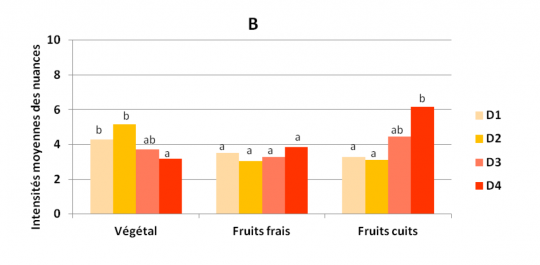The harvest date is a key decision in the production of high-quality wine. The organoleptic profile is highly impacted by this crucial factor.
For this reason, experiments are regularly conducted, as well as frequent monitoring of ripeness.
These results are from an experiment carried out as part of Lucille Allamy's thesis, partly financed by Château Latour. The objective was to characterize the impact of the harvest date on the presence of aromatic compounds such as cooked fruit (or their precursors).
3.1.1.e Feedback from experimentation: impact of the harvest date on aromatic profile
Method
Two plots were selected, one of Merlot and one of Cabernet Sauvignon.
Four harvest dates were studied:
- D1, corresponding to 4 days before the planned harvest date
- D2, the normal harvest date (control)
- D3, 4 days after D2
- D4, 8 days after D2
The musts and finished wines were tasted and analysed for 6 months after vinification for certain aromatic markers such as MND and γ-nonalactone, which are indicators of premature ageing reminiscent of figs, prunes, and cooked fruit.
| Molecule | Aromatic type | Perception threshold in wine |
|---|---|---|
| γ-nonalactone | Cooked fruits | 25 µg/L |
| MND | Figs, dried prunes | 64 ng/L |
γ-nonalactone was significantly more present for grapes harvested later and any differences further increased after 6 months, implying that there were also more precursors of this molecule.
After 6 months in the bottle, there were three distinct categories: D1, D2/D3 and then D4. The amount of MND increased over time and passed the olfactory detection threshold in D4 after only 6 months. This suggests an even greater increase at the end of ripening which then continues during bottle ageing.
Conclusion
The harvest date has a major impact on the wines' aromatic profile.
If it is too late, it will have significant consequences, particularly on ageing potential, since the quantity of molecules or their precursors, such as cooked fruit, increases with a later harvest. This choice of date therefore has a long-term impact on the wines' character and leads us to seek more balanced ripeness.



